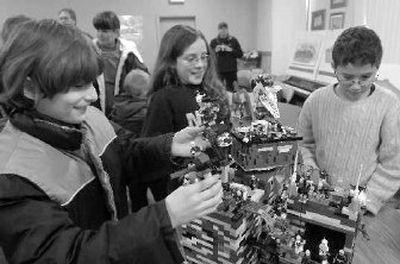Inside our Schools: Lego ban intrigues local educators

Brightly colored Lego building blocks have infatuated kids for more than 60 years. Children all over the world spend about 5 billion hours total each year playing with the toys, according to the Lego Co. Just the other week, a Lego-building contest sponsored by the Coeur d’Alene Library attracted 100 participants.
But a press release from the publication Rethinking Schools shows not everyone thinks quite as highly of the popular toys.
“Why we banned Legos,” the press release declares in bold letters.
The release is touting the publication’s newest issue, which features a cover story written by Seattle teachers Ann Pelo – a Spokane native – and Kendra PeloJoaquin that details an incident that occurred at the Seattle children’s center where they work, the Hilltop Children’s Center.
Children in the center’s after-school program had constructed an elaborate collection of Lego buildings, calling it Legotown. But as Pelo and her colleagues observed how the children played with the structures and how Legotown was run, they became concerned.
“What started to happen was the group of kids who had constructed Legotown really kind of closed access to the Legos for a lot of kids,” Pelo said in a phone interview. “It became what we came to call … Lego-oligarchy.”
So when Legotown was dismantled by other kids using the center, Pelo and her colleagues decided that, instead of rebuilding, the toys should be removed from the center. It wasn’t permanent. The toys came back, but not before the kids created guidelines for playing with the toys that prevent them from teaming up against one another.
“For us, (Legos) became inherently problematic because of sort of the unexamined issues of power and authority,” Pelo said. “It felt to us that it was this opportunity to explore this bigger issue – how we’re going to all live in a community. … It was about how can we make our community more fair about Legos.”
The approximately 25 kindergarten through fourth-grade students in the after-school program came up with guidelines for how Legos could be part of activities without invoking the social class structures Pelo and her colleagues observed.
Playing with Legos is now governed by three rules: All structures are owned by everyone; structures should adhere to size requirements so as to not create inequity; and the plastic Lego people can only be used by a group of people, not by individuals.
“Kids came to a pretty strikingly profound understanding of the ways in which private ownership falls short, or the ways in which private ownership is inherently unfair,” Pelo said.
Local educators were intrigued by Pelo’s thoughts on the popular toy.
“I hadn’t heard that before,” said Barney Brewton, director of elementary education for the Post Falls School District. Though the toys aren’t part of regular classroom activity, they’re great building blocks and a positive playtime activity, he said. “They’re sometimes used as instructional tools.”
Donna Cork, interim executive director of School Indigo, a private alternative school in Coeur d’Alene, said her students use Legos regularly.
“It’s a daily occurrence,” Cork said. “They do use them for various activities. They can use them for color recognition; they can be used for physics things and things like that.”
Julie Billetz, principal of the Post Falls Kindercenter, where all Post Falls kindergartners go, said many teachers have Lego stations in their classrooms.
“The kids seem to really enjoy them,” Billetz said. “I wouldn’t ban them.”
Pelo, too, understands the value of Legos and doesn’t want anyone to think the toys should be banned completely.
“Because they’re so open-ended, they really are a great material for kids to sort of, in their play, reflect their understanding of the world,” Pelo said.
Pelo advises anyone with children who play with Legos to pay close attention to what the kids are building with them.
“What do they get excited about?” Pelo said. “Use their construction work to learn more about their thinking.”
Pelo has authored other articles on early childhood education, including the book “That’s Not Fair: A Teacher’s Guide to Activism with Young Children.”
Conservative author Bernard Goldberg listed her as No. 51 in his book “100 People Who Are Screwing Up America.”
Pelo denied the claim.